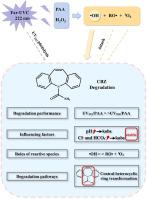当前位置:
X-MOL 学术
›
Water Res.
›
论文详情
Our official English website, www.x-mol.net, welcomes your feedback! (Note: you will need to create a separate account there.)
Enhanced degradation of emerging contaminants by Far-UVC photolysis of peracetic acid: Synergistic effect and mechanisms
Water Research ( IF 11.4 ) Pub Date : 2024-06-14 , DOI: 10.1016/j.watres.2024.121943 Chen-Yan Hu 1 , Li-Li Hu 2 , Zheng-Yu Dong 2 , Xin-Yu Yang 2 , Hao Liu 2 , Jia-Nan Chen 2 , Ling-Mei Gao 2
Water Research ( IF 11.4 ) Pub Date : 2024-06-14 , DOI: 10.1016/j.watres.2024.121943 Chen-Yan Hu 1 , Li-Li Hu 2 , Zheng-Yu Dong 2 , Xin-Yu Yang 2 , Hao Liu 2 , Jia-Nan Chen 2 , Ling-Mei Gao 2
Affiliation

|
Krypton chloride (KrCl*) excimer lamps (222 nm) are used as a promising irradiation source to drive ultraviolet-based advanced oxidation processes (UV-AOPs) in water treatment. In this study, the UV/peracetic acid (PAA) process is implemented as a novel UV-AOPs for the degradation of emerging contaminants (ECs) in water. The results demonstrate that UV/PAA process exhibits excellent degradation performance for carbamazepine (CBZ), with a removal rate of 90.8 % within 45 min. Notably, the degradation of CBZ in the UV/PAA process (90.8 %) was significantly higher than that in the UV/PAA process (15.1 %) at the same UV dose. The UV/PAA process exhibits superior electrical energy per order (EE/O) performance while reducing resource consumption associated with the high-energy UV/PAA process. Quenching experiments and electron paramagnetic resonance (EPR) detection confirm that HO• play a dominant role in the reaction. The contributions of direct photolysis, HO•, and other active species (RO• and O) are estimated to be 5 %, 88 %, and 7 %, respectively. In addition, the effects of Cl, HCO, and humic acid (HA) on the degradation of CBZ are evaluated. The presence of relatively low concentrations of Cl, HCO, and HA can inhibit CBZ degradation. The UV/PAA oxidation process could also effectively degrade several other ECs (i.e., iohexol, sulfamethoxazole, acetochlor, ibuprofen), indicating the potential application of this process in pollutant removal. These findings will propel the development of the UV/PAA process and provide valuable insights for its application in water treatment.
中文翻译:

通过远紫外线光解过氧乙酸增强新兴污染物的降解:协同效应和机制
氯化氪 (KrCl*) 准分子灯 (222 nm) 被用作驱动水处理中基于紫外线的高级氧化工艺 (UV-AOP) 的有前景的照射源。在这项研究中,UV/过氧乙酸 (PAA) 工艺作为一种新型 UV-AOP 实施,用于降解水中新出现的污染物 (EC)。结果表明,UV/PAA工艺对卡马西平(CBZ)表现出优异的降解性能,45分钟内去除率为90.8%。值得注意的是,在相同的紫外线剂量下,CBZ 在 UV/PAA 过程中的降解 (90.8%) 显着高于 UV/PAA 过程中的降解 (15.1%)。 UV/PAA 工艺展现出卓越的每订单电能 (EE/O) 性能,同时减少了与高能 UV/PAA 工艺相关的资源消耗。淬火实验和电子顺磁共振(EPR)检测证实H2O·在反应中起主导作用。直接光解、H2O• 和其他活性物质(RO• 和 O)的贡献估计分别为 5%、88% 和 7%。此外,还评估了 Cl、HCO 和腐殖酸 (HA) 对 CBZ 降解的影响。相对较低浓度的 Cl、HCO 和 HA 的存在可以抑制 CBZ 降解。 UV/PAA氧化过程还可以有效降解其他几种EC(即碘海醇、磺胺甲恶唑、乙草胺、布洛芬),表明该过程在污染物去除方面的潜在应用。这些发现将推动 UV/PAA 工艺的发展,并为其在水处理中的应用提供宝贵的见解。
更新日期:2024-06-14
中文翻译:

通过远紫外线光解过氧乙酸增强新兴污染物的降解:协同效应和机制
氯化氪 (KrCl*) 准分子灯 (222 nm) 被用作驱动水处理中基于紫外线的高级氧化工艺 (UV-AOP) 的有前景的照射源。在这项研究中,UV/过氧乙酸 (PAA) 工艺作为一种新型 UV-AOP 实施,用于降解水中新出现的污染物 (EC)。结果表明,UV/PAA工艺对卡马西平(CBZ)表现出优异的降解性能,45分钟内去除率为90.8%。值得注意的是,在相同的紫外线剂量下,CBZ 在 UV/PAA 过程中的降解 (90.8%) 显着高于 UV/PAA 过程中的降解 (15.1%)。 UV/PAA 工艺展现出卓越的每订单电能 (EE/O) 性能,同时减少了与高能 UV/PAA 工艺相关的资源消耗。淬火实验和电子顺磁共振(EPR)检测证实H2O·在反应中起主导作用。直接光解、H2O• 和其他活性物质(RO• 和 O)的贡献估计分别为 5%、88% 和 7%。此外,还评估了 Cl、HCO 和腐殖酸 (HA) 对 CBZ 降解的影响。相对较低浓度的 Cl、HCO 和 HA 的存在可以抑制 CBZ 降解。 UV/PAA氧化过程还可以有效降解其他几种EC(即碘海醇、磺胺甲恶唑、乙草胺、布洛芬),表明该过程在污染物去除方面的潜在应用。这些发现将推动 UV/PAA 工艺的发展,并为其在水处理中的应用提供宝贵的见解。
















































 京公网安备 11010802027423号
京公网安备 11010802027423号